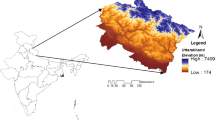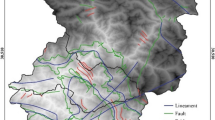Abstract
The objective of this study is to i) investigate the effects of orography on the rainfall, wind, and cloud systems of the Typhoon Ketsana (2009) in Indochina, ii) determine rainfall distribution patterns and which parts of Indochina were most affected during Typhoon Ketsana, iii) identify trends in the cloud and rainfall distribution patterns and wind flow patterns in the synoptic scale on orographic effects during Typhoon Ketsana. Remote sensing techniques have been used to study the impacts of TCs. Using data from the remote sensing data such as Fengyun 2D (FY-2D) satellite, Global Digital Elevation Model (GDEM) from the Advanced Spaceborne Thermal Emission and Reflection Radiometer (ASTER) satellite, wind information from the Navy Operational Global Atmospheric Prediction System (NOGAPS), and radiosonde data were applied in this study to determine the relationship of the typhoon with the orographic effect. This study provides examples of how the orographic effect is important to weather forecasters, as high mountain ranges were able to influence the distribution of the cloud, rainfall and even wind flow patterns during the typhoon season. This remote sensing technique allows tropical cyclones to be forecasted and their impacts to be defined, and it allows disaster zones to be determined.
Similar content being viewed by others
References
Baik, J. -J., M. Demaria, and S. Raman, 1990a: Tropical Cyclone Simulations with the Betts Convective Adjustment Scheme. Part I: Model Description and Control Simulation. Mon. Wea. Rev., 118, 513–528.
—, —, and —, 1990b: Tropical Cyclone Simulations with the Betts Convective Adjustment Scheme. Part II: Sensitivity Experiments. Mon. Wea. Rev., 118, 529–541.
Bender, M. A., R. E. Tuleya, and Y. Kurihara, 1985: A Numerical Study of the Effect of a Mountain Range on a Landfalling Tropical Cyclone. Mon. Wea. Rev., 113, 567–582.
—, —, and —, 1987: A Numerical Study of The Effect of Island Terrain on Tropical Cyclones. Mon. Wea. Rev., 115, 130–155.
Benfield, A., 2009: Annual Global Climate and Catastrophe Report: Impact Forecasting 2009, 66 pp.
Brand, S., and J. W. Blelloch, 1974: Changes in the Characteristics of Typhoons Crossing the Island of Taiwan. Mon. Wea. Rev., 102, 708–713.
Caine, N., 1980: The Rainfall Intensity: Duration Controls On Shallow Landslides And Debris Flows. Geogr. Ann., 62A, 23–27.
Chang, S. W., and R. V. Madala, 1982: The Orographic Effects Induced by an island Mountain Range on Propagrating Tropical Cyclones. Mon. Wea. Rev., 110, 1255–1270.
Colón-Pagán, I. C., 2009: Orographic Effects on Rainfall Induced by the Passage of Tropical Cyclones over Mountainous Islands: Part I: The Effect of Cloud Microphysics. Colón-Pagán, SOARS 2009, 1–25.
Davies, J. M., 2004: Estimations of CIN and LFC associated with tornadic and nontornadic supercells. Wea. Forecasting, 19, 714–726.
—, 2006a: Hurricane and tropical cyclone tornado environments from RUC proximity sounding. Preprints, 23rd Conf. Severe Local Storms, St. Louis, MO, Amer. Meteor. Soc., P8.1.
—, 2006b: Total CAPE, low-level CAPE, and LFC in significant tornado events with relatively high LCL heights. Preprints, 23rd Conf. Severe Local Storms, St. Louis, MO, Amer. Meteor. Soc., 1–3.
Fernando, C., M. R. A., H. L. Ray, and C. C. F., 1979: Mesoanalysis Of The Big Thompson Storm. Mon. Wea. Rev., 107, 1–17.
Frank, R., F. C. M, A. L. B, and Olivier, 2004: Structure and Evolution of Intense Tropical Cyclone Dina near La Réunion on 22 January 2002: GB-EVTD Analysis of Single Doppler Radar Observations. J. Atmos. Oceanic Technol., 21, 1501–1518.
Haby, J., cited 2011: Skew-T: A Look at CINH. [Available online at http://www.theweatherprediction.com/habyhints/306/.]
Huang, Y. -H., C. -C. Wu, and Y. Wang, 2011: The influence of island topography on typhoon track deflection. Mon. Wea. Rev., 139, 1708–1727.
Inness, P., 2008: Weather. Hodder Education, 256 pp.
Jian, G.-J., and C.-C., Wu, 2008: A numerical study of the track deflection of super-typhoon Haitang (2005) prior to its landfall in Taiwan. Mon. Wea. Rev., 136, 598–615.
Li, P. C., 1963: Terrain effects on typhoons approaching Taiwan. Porc. U. S. Asian Military Weather Symp.
Liang, J., L. Wu, X. Ge, and C. -C. Wu, 2012: Monsoonal Influence on Typhoon Morakot (2009). Part II: Numerical Study. J. Atmos. Sci. (in press).
Lin, Y. -L., J. Han, D. W. Hamilton, C.-Y., Huang, 1999: Orographic influence on a drifting Cyclone. J. Atmos. Sci., 56, 534–562.
—, S.-Y. Chen, C. M. Hill, and C.-Y. Huang, 2005: Control parameters for the influence of a mesoscale mountain range on cyclone track continuity and deflection. J. Atmos. Sci., 62, 1849–1866.
McCaul, E. W., 1991: Buoyancy and Shear Characteristics of Hurricane-Tornado Environments. Mon. Wea. Rev., 119, 1954–1978.
Naik, A., cited 2011: Orographic Effect. [Available online at http://www.buzzle.com/articles/orographic-effect.html.]
Pan, C. J., K. K. Reddy, H. C. Lai, and S. S. Yang, 2010: Wind profiler observations on orographic effects of typhoon wind structure modification over Taiwan (120.38°E, 22.6°N). Ann. Geophys., 28, 141–147.
Polvani, L. M. and P. J. Kushner, 2002: Tropospheric response to stratospheric perturbations in a relatively simple general circulation model. Geophys. Res. Lett., 29, 18.1–18.4.
Rodgers, E. B., J. -J. Baik, and H. F. Pierce, 1994: The environmental influence on tropical cyclone precipitation. J. Appl. Meteorol., 33, 573–593.
Song, Y. a. W. A. R., 2004: Dynamical mechanisms for stratospheric influences on the troposphere. J. Atmos. Sci. 61, 1711–1725.
Smith, II. B. L., Y. -L. Lin, and H. D. Reeves, 2006: Effects of cyclone track on precipitation distribution along the California Coastal Range and Sierra Nevada. 12th Conf. on Mountain Meteorology.
Tao, W. -K., and Coauthors, 2011: High-Resolution Numerical Simulation of the Extreme Rainfall Associated with Typhoon Morakot. Part I: Comparing the Impact of Microphysics and PBL Parameterizations with Observations. Terr. Atmos. Oceanic Sci., 22, 673–696. doi: 10.3319/TAO.2011.08.26.01(TM).
Thompson, R., cited 2011: Explanation of SPC Severe Weather Parameters. [Available online at http://www.spc.noaa.gov/sfctest/help/begin.html.]
Wu, C. -C., and Y. -H. Kuo, 1999: Typhoons affecting Taiwan: current understanding and future challenges. Bull. Amer. Meteor. Soc., 80, 67–80.
—, 2001: Numerical simulation of Typhoon Gladys (1994) and its interaction with Taiwan terrain using the GFDL hurricane model. Mon. Wea. Rev., 129, 1533–1549.
—, T. -H. Yen, Y. -H. Kuo, and W. Wang, 2002: Rainfall simulation associated with Typhoon Herb (1996) near Taiwan. Part I: The topographic effect. Wea. Forecasting, 17, 1001–1015.
Yeh, T. C. and R. L. Elsberry, 1993a: Interaction of Typhoons with the Taiwan Orography. Part I: Upstream Track Deflections. Mon. Wea. Rev., 121, 3193–3212.
—, and —, 1993b: Interaction of Typhoons with the Taiwan Orography. Part II: Continuous and Discontinuous Tracks across the Island. Mon. Wea. Rev., 121, 3213–3233.
Yen, T. -H., C. -C. Wu, G. -Y. Lien, 2011: Rainfall simulations of Typhoon Morakot with controlled translation speed based on EnKF data assimilation. Terr. Atmos. Ocean. Sci., 22, 647–660. doi:10.3319/ TAO.2011.07.05.01(TM)
Author information
Authors and Affiliations
Corresponding author
Rights and permissions
About this article
Cite this article
Tan, F., Lim, H.S. & Abdullah, K. The effects of orography in indochina on wind, cloud, and rainfall patterns during Typhoon Ketsana (2009). Asia-Pacific J Atmos Sci 48, 295–314 (2012). https://doi.org/10.1007/s13143-012-0029-z
Received:
Revised:
Accepted:
Published:
Issue Date:
DOI: https://doi.org/10.1007/s13143-012-0029-z




